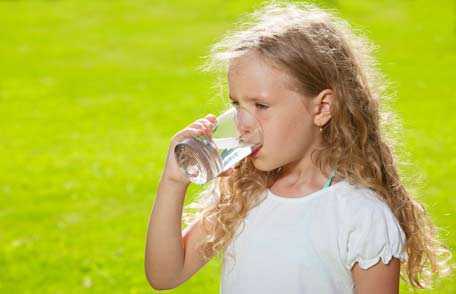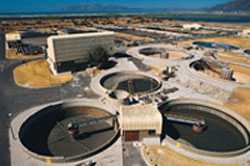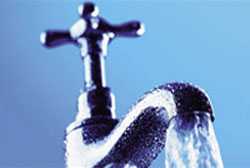Drinking Water Week

May 7–13, 2017, is Drinking Water Week. Drinking Water Week is observed each year in May to recognize the role drinking water plays in our daily lives. “Your water: To know it is to love it!” is this year’s theme, and it encourages everyone to get to know more about the water they drink.
How Many Times a Day Do You Use Water From a Faucet?
Have you ever stopped to think about how many times a day you use water from a faucet? Drinking water refers to the water that comes out of our tap or bottled water. Americans use drinking water many times a day, every day, for many different activities such as drinking, bathing, cooking, and washing clothes, to name a few. The United States has one of the safest drinking water supplies in the world, and it’s important to know how that water gets to our faucets and what makes it safe to use.
However, new challenges require us to continue to work to protect our water supply. Drinking water systems in the United States are aging, and most are long overdue for replacement.
During Drinking Water Week, learn more about where your drinking water comes from, what makes it safe to use, and what CDC is doing to address challenges to our water supply.

Although the United States has one of the safest drinking water supplies in the world, we must continue to work to protect our water supply.

Treating water to remove or kill disease-causing contaminants is critical.

CDC works to address drinking water challenges through research, prevention, and policy activities and programs.
Keeping Tap Water Safe and Healthy
Over the last 100 years, many improvements in the health, success, and lifespan of the U.S. population can be linked to improvements in water quality. Providing safe drinking water was one of the most important public health achievements of the 20th century.1 Water treatment and disinfection (methods to get rid of germs or chemicals that cause illness) has helped ensure access to healthy and safe water for millions of Americans.
Government regulations have helped reduce pollution of the bodies of water that supply our drinking water systems over the years. However, treating water to remove or kill contaminants like germs or chemicals is still critical to make sure that water is safe to drink. Contamination of drinking water sources can occur at multiple points, including:
- In the original water source (for example, a river).
- Through inadequate water treatment.
- In storage tanks.
- In drinking water distribution systems (the pipes that carry water to homes, businesses, schools, and other buildings).
The Environmental Protection Agency (EPA) regulates drinking water quality in public water systems. Every public water system is required to provide its customers with an annual consumer confidence report (CCR), which provides information on local drinking water quality.
Drinking Water and Private Wells
EPA regulations often do not apply to privately owned wells, although some states do regulate private wells. As a result, millions of Americans who get their water from private wells are responsible for ensuring that their water is safe from contaminants. A local health department or well water system professional can provide assistance on well maintenance, new well construction, and water quality testing.
The Future of Tap Water
Drinking water systems in the United States are up to 100 years old in some places. Cracked pipes, water main breaks, and other age-related issues increase the chance for germs or chemicals to get into the water and can lead to boil water advisories. The American Water Works Association has estimated that it will cost nearly $1 trillion in the next 25 years to repair and expand our drinking water systems to meet the demands of a growing population. Other challenges include warming temperatures, which can affect our water supply, and contamination of water sources with chemicals and toxins.
What CDC is Doing
CDC works to address these drinking water challenges through its water-related research, prevention, and policy activities and programs, including:
Research on Health Impacts
- Providing support for state and local health officials to investigate, report, and prevent illnesses associated with drinking water systems and private wells.
- Estimating the number of illnesses and costs associated with waterborne disease and outbreaks.
- Identifying the health impacts of aging drinking water infrastructure and well water usage to develop strategies for improvement.
- Tracking the epidemiology of established and emerging waterborne diseases.
- Identifying and testing environmental factors that contribute to waterborne disease.
- Developing improved laboratory methods for sampling, testing, and monitoring water quality.
Preventing Waterborne Disease and Protecting Public Health
- Working with EPA and other partners to provide guidance on drinking water policy and research priorities.
- Investigating whether disruptions in drinking water service (like a pipe break) affect water quality and people’s health.
- Developing tools and resources to respond to water-related emergencies.
- Supporting public health agencies to strengthen their drinking water programs and address problems with wells and other private drinking water sources.
- Applying study findings to improve waterborne disease prevention outreach, education, policies, and practices.
- Providing national leadership on community water fluoridation practice.
References
- Cutler D, Miller G. The role of public health improvements in health advances: the twentieth-century United States. Demography. 2005;42(1):1-22.
More Information
More Information
Public drinking water quality and your local drinking water:
- CDC — Drinking Water
- CDC — Healthy Water Website
- CDC — Health Studies Branch — Promoting Clean Water For Health
- CDC — Understanding Consumer Confidence Reports (CCR)
- EPA — Drinking Water Contaminants
- EPA — Ground Water and Drinking Water
How to protect and improve well water quality:
- CDC Feature – Ground Water Awareness Week
- CDC – Safe WATCH
- EPA — Private Drinking Water Wells
- USGS — Quality of Water from Domestic Wells in the United States
- The Private Well Class: Free Online Training for Homeowners with Water Wells
Other drinking water and health-related resources:
- Page last reviewed: April 28, 2017
- Page last updated: April 28, 2017
- Content source:
- National Center for Emerging and Zoonotic Infectious Diseases, Division of Foodborne, Waterborne, and Environmental Diseases
- Page maintained by: Office of the Associate Director for Communication, Digital Media Branch, Division of Public Affairs




 ShareCompartir
ShareCompartir